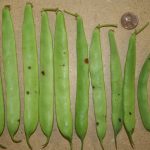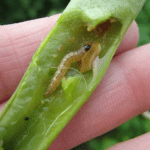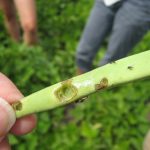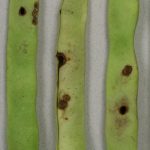Twenty-eight of the 35 sites reporting this week. European corn borer (ECB)-E was trapped at five sites and ECB-Z was trapped at seven sites. Corn earworm (CEW) was trapped at sixteen sites, with forteen sites high enough to be on a 4, 5 or 6 day spray schedule (see chart below). Fall armyworm (FAW) was caught at seven sites and Western bean cutworm (WBC) numbers really went up this week with 25 sites reporting catches.
Below is a graph showing the average trap catch for all reporting sites since the beginning of the trapping season. WBC and CEW numbers went up a bit this week. Peak WBC flight is expected to occur the first week of August. Be sure to scout your pretassel corn for egg masses. And to determine estimated WBC flight completion refer to the lookup table using the base 38F column.
If the map is not visible and you are using Firefox as your browser, be sure to turn off enhanced tracking by going to the blue shield icon to the left of the URL address bar.
Dry Bean Western Bean Cutworm Alert
7.16.24
This year we are monitoring 16 WBC traps placed next to dry bean fields. Dry bean growers should scout adjacent corn for WBC eggs and larvae when cumulative trap catch reaches 50 moths. Peak WBC flight historically occurs the first week of August. All dry bean growers should begin scouting pods for WBC feeding about 10 days after peak flight regardless of cumulative trap catch, and should continue to scout for three weeks, especially if damage has been seen in recent years.
Check 10 random spots in a field, 5 plants per spot. Inspect all the pods on the plants looking for holes. Surface feeding can be caused by other insects. WBC will mine directly into the pod and will often feed on the seed inside. European corn borer will also feed inside the pod and would most likely still be present. If there is damage going directly into the pod and seed but no larva present, it is quite possibly WBC. During the day WBC larva are not actively feeding in the pod, instead they drop to the soil and will remain there until night. Fresh damage will be green, not brown.
- Early damage made by small WBC larvae.
- ECB in pod.
- Damage caused by slug feeding, note slime trail.
- Later feeding damage going through pod and into beans.
This project is funded by the NYS Dry Bean Industry.









